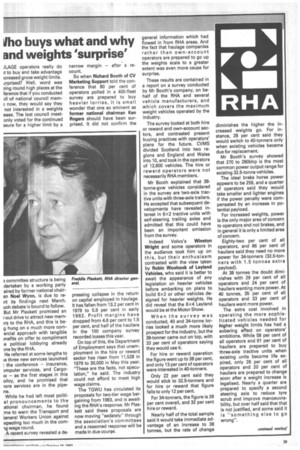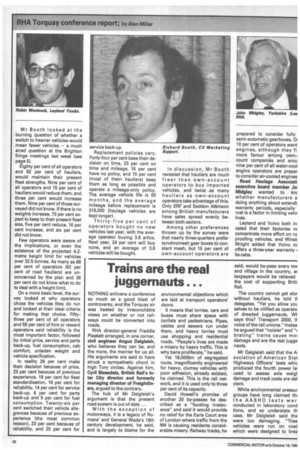RHA
Page 21

Page 22

If you've noticed an error in this article please click here to report it so we can fix it.
diminishes the higher the increased weights go. For instance, 28 per cent said they would switch to 40-tonners only when existing vehicles became due for replacement.
Mr Booth's survey showed that 270 to 280bhp is the most common power output range for existing 32.5-tonne vehicles.
The ideal brake horse power appears to be 259, and a quarter of operators said they would take smaller and lighter engines if the power penalty were compensated by an increase in potential payload.
For increased weights, power is the only major area of concern to operators and not brakes, and in general it is only a limited area of concern.
Eighty-two per cent of all operators, and 86 per cent of hauliers said they need no more power for 34-tonners (32.5-tanners with 1.5 tonnes extra payload).
At 38 tonnes the doubt diminishes with 29 per cent of all operators and 24 per cent of hauliers wanting more power. At 40 tonnes, 35 per cent of all operators and 33 per cent of hauliers want more power.
The extra cost involved in operating the more sophisticated vehicles needed for higher weight limits has had a sobering effect on operators' ambitions. While 58 per cent of all operators and 61 per cent of hauliers are prepared to buy three-axle tractive units when existing units become life expired, only 26 per cent of all operators and 20 per cent of hauliers are prepared to change soon after a weight increase is legalised. Nearly a quarter are prepared to specify a second steering axle to reduce tyre scrub and improve manoeuvrability, but over half said that that is not justified, and some said it is "something else to go wrong".
Mr Booth looked at the burning question of whether a switch to heavier vehicles would mean fewer vehicles — a much aired question at the Brighton fringe meetings last week (see page 5).
Eighty per cent of all operators and 82 per cent of hauliers, would maintain their present fleet strengths. Nine per cent of all operators and 15 per cent of hauliers would reduce them, and three per cent would increase them. Nine per cent of those surveyed did not know. If there is no weights increase, 73 per cent expect to keep to their present fleet size, five per cent reduce, 16 per cent increase, and six per cent did not know.
Few operators were aware of the implications, or even the existence of the projected 4.2metre height limit for vehicles over 32.5 tonnes. As many as 68 per cent of operators (62 per cent of road hauliers) are unconcerned by the plan and 36 per cent do not know what to do to deal with a height limit.
On a more basic level, the survey looked at why operators chose the vehicles they do run and looked at their ideal criteria. for making that choice. Fiftythree per cent of all operators and 55 per cent of hire or reward operators said reliability is the most important factor, followed by initial price, service and parts back-up, fuel consumption, cab comfort, unladen weight and vehicle specification.
In reality 29 per cent make their decision because of price, 23 per cent because of previous experience, 18 per cent for fleet standardisation, 16 per cent for reliability, 14 per cent for service back-up, 6 per cent for parts back-up and 5 per cent for fuel consumption. Twenty-six per cent switched their vehicle allegiances because of previous experience (the most common reason), 23 per cent because of reliability, and 20 per cent for
service back-up.
Replacement policies vary. Forty-four per cent base their decision on time, 23 per cent on time and mileage, 16 per cent have no policy, and 15 per cent (most of them hauliers) keep them as long as possible and operate a mileage-only policy. The average vehicle life is 63 months, and the average mileage before replacement is 318,000 (haulage vehicles are kept longer).
Thirty-five per cent of operators bought no new vehicles last year, with the average operator buying 3.6 artics. Next year, 24 per cent will buy none, and an average of 3.8 vehicles will be bought. In discussion, Mr Booth revealed that hauliers are much freer than own-account operators to buy imported vehicles, and twice -as many hauliers as own-account operators take advantage of this. Only ERF and Seddon Atkinson among British manufacturers have sales spread evenly between both sectors.
Among other preferences thrown up by the survey were that nearly three-quarters prefer synchromesh gear boxes to constant mesh, but 15 per cent of own-account operators are prepared to consider fully semi-automatic gearboxes. Oi 10 per cent of operators want engines, although they fi more favour among own-1 count companies and arou nine per cent of all water-cool engine operators are prepar to consider air-cooled engines Road Haulage Associatii executive board member Jol Midgley wanted to knc whether manufacturers a doing anything about extendil warranty periods, especially rust is a factor in limiting vehit lives.
Leyland and Volvo both in. cated that their factories nc concentrate more effort on ru proofing vehicles, and Winsti Wright added that Volvo nc offers a three-year warranty its cabs.




















































































